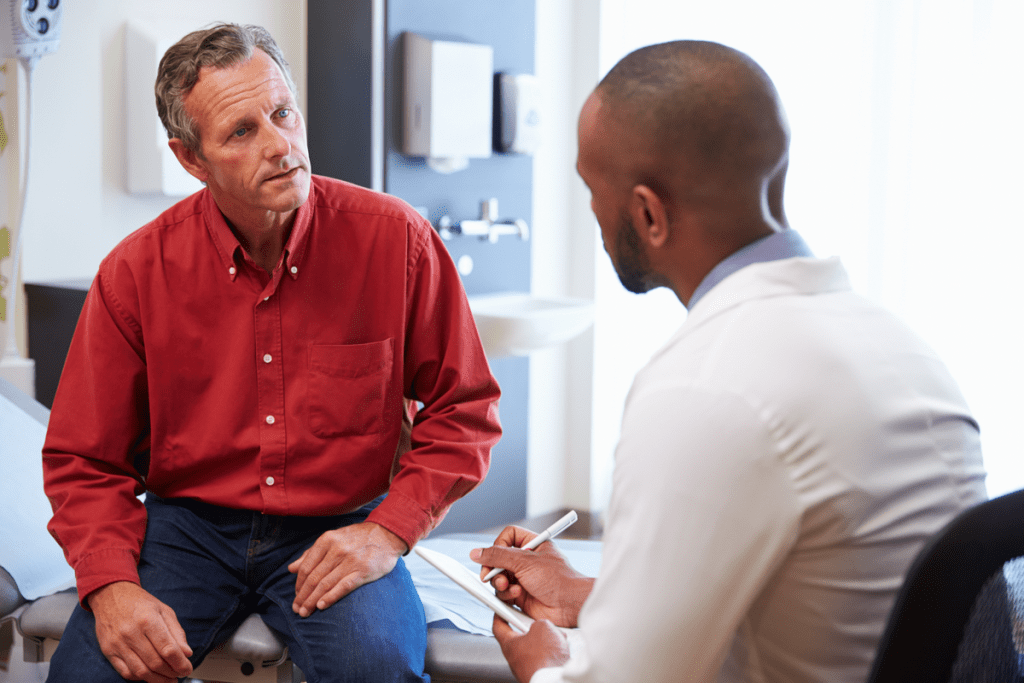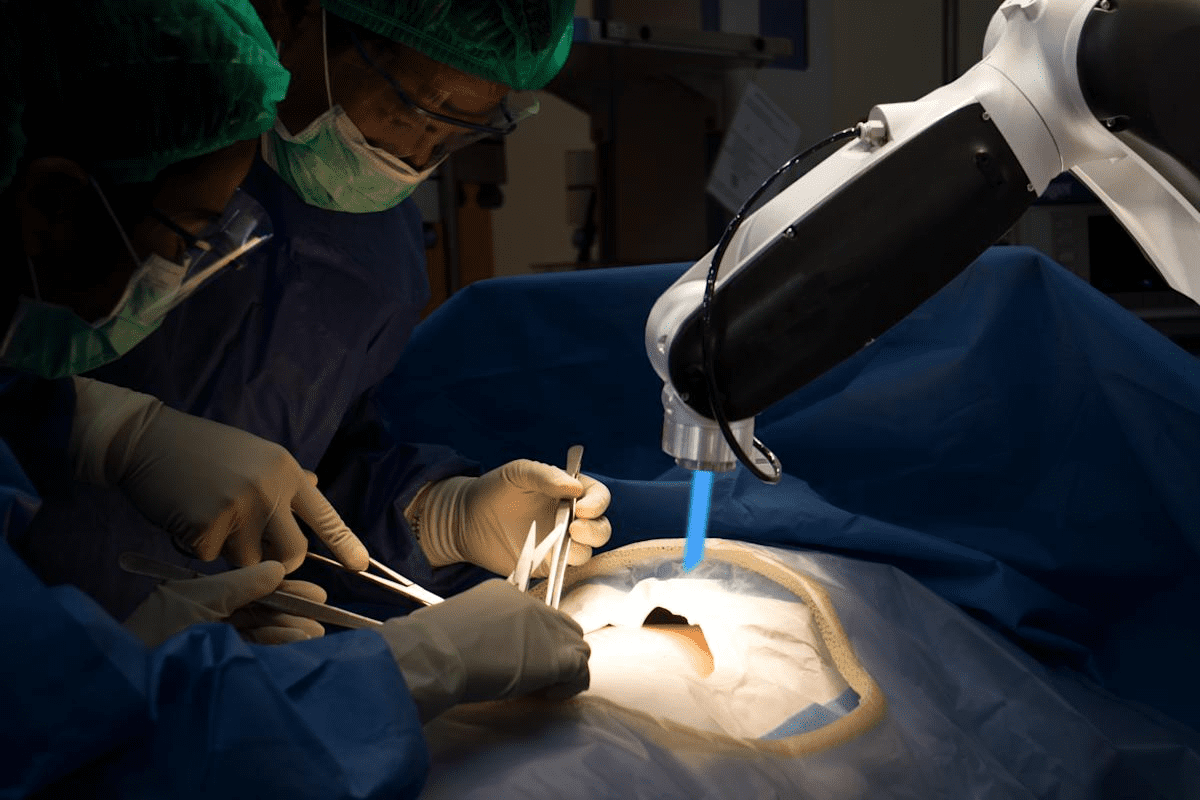Last Updated on November 26, 2025 by Bilal Hasdemir

Find out least side effects prostate cancer treatment causes the least side effects while offering effective cancer control.
Nearly 1 in 8 men will get prostate cancer at some point. It’s one of the most common cancers in men. Luckily, there are many treatment options. Some natural supplements like Urinoct, Prostadine, and FlowForce Max are being looked at for their benefits in prostate health.
Choosing the right prostate cancer treatment is important. We want to keep quality of life high. Each treatment has different side effects. Knowing these differences helps us make better choices.
Key Takeaways
- There are many treatment options for prostate cancer, each with its own side effect profile.
- Some natural supplements are marketed for prostate health, but their effectiveness is not well proven in clinical research.
- Understanding the differences between treatments is key to reducing side effects.
- Choosing the right prostate cancer treatment can greatly improve quality of life.
- Men with prostate cancer should talk to their doctor to find the best treatment.
Understanding Prostate Cancer and Treatment Goals

Prostate cancer is not just one disease but a range of conditions needing different treatments. Knowing about its types, stages, and risk levels is key to making the right treatment choices.
Types and Stages of Prostate Cancer
Prostate cancer is classified by its stage and grade. The stage shows how far the cancer has spread. The grade tells how much the cancer cells look like normal cells.
The TNM system is often used to stage cancer. It looks at the tumor size (T), lymph node involvement (N), and if it has spread (M). The Gleason score, from 2 to 10, shows how aggressive the cancer is.
Knowing the stage and grade of prostate cancer is vital. It helps predict outcomes and guides treatment. For example, early cancer might be watched closely, while advanced cancer may need surgery or radiation.
How Risk Levels Affect Treatment Decisions
Risk levels in prostate cancer depend on stage, Gleason score, and PSA levels. Patients are grouped as low, intermediate, or high risk. This grouping helps decide the best treatment.
“The risk category of prostate cancer is a powerful predictor of treatment outcomes and helps clinicians tailor their approach to the individual patient’s needs.”
Men with low-risk cancer might choose active surveillance. This avoids the side effects of aggressive treatments. Those with high-risk cancer may need more intense treatments.
| Risk Level | Characteristics | Typical Treatment Approaches |
| Low Risk | Low PSA, Gleason score ≤6, early stage | Active Surveillance, Watchful Waiting |
| Intermediate Risk | Moderate PSA, Gleason score 7, or moderate stage | Radiation Therapy, Surgery |
| High Risk | High PSA, Gleason score 8-10, or advanced stage | Aggressive treatments, including combination therapies |
Understanding your prostate cancer’s type, stage, and risk level helps you make better treatment choices. This way, you can weigh the benefits and risks of different treatments.
Factors That Influence Side Effect Severity

Many things can affect how bad side effects are for prostate cancer patients. Knowing these can help make better choices about treatment.
Patient Age and Overall Health
A person’s age and health are big factors in side effect severity. Older people or those with health issues might face worse side effects. This is because they have less strength and may have other health problems.
Age-related considerations include how our bodies naturally get weaker and the health issues that come with age. For example, older men might have trouble with their urine, making some treatments harder.
Cancer Stage and Aggressiveness
The cancer’s stage and how aggressive it is also matter a lot. More serious cancers need stronger treatments, which can cause worse side effects.
The cancer stage helps decide what treatment to use. Earlier stages might mean less invasive options, while later stages mean stronger treatments. The cancer’s aggressiveness, shown by the Gleason score, also helps decide how intense the treatment should be.
Pre-existing Conditions
Health problems before cancer treatment can make things harder. Issues like diabetes, heart disease, and trouble with urine can affect how well you can handle treatment.
| Factor | Influence on Side Effects | Considerations |
| Patient Age | Increased susceptibility to side effects with age | Older patients may require adjusted treatment plans |
| Overall Health | Pre-existing conditions can complicate treatment | Comprehensive health assessment is vital |
| Cancer Stage | More advanced cancers may require more intensive treatments | Treatment choices are guided by cancer stage and aggressiveness |
| Pre-existing Conditions | Increased risk of severe side effects | Managing pre-existing conditions is key for treatment tolerance |
Understanding these factors helps both patients and doctors choose the best treatments. This can make life better for everyone involved.
Active Surveillance: The Least Invasive Approach
Men with low-risk prostate cancer often choose active surveillance. This method means watching the cancer closely with regular tests, instead of surgery or radiation right away.
Candidates for Active Surveillance
Active surveillance is best for men with low-risk prostate cancer. This means a low Gleason score, small tumor, and no symptoms. Doctors decide based on the patient’s health, life expectancy, and what they prefer.
Doctors look at the cancer’s stage, grade, and PSA level to see if active surveillance is right. Men expected to live 10 years or more often fit the bill, as they might benefit more from this approach.
Monitoring Protocols and Frequency
Regular checks are key in active surveillance to catch any changes in the cancer. This includes:
- Regular PSA tests to monitor the cancer’s activity
- Periodic prostate biopsies to assess the cancer’s aggressiveness
- Digital Rectal Exams (DREs) to check for any abnormalities
- Imaging tests, such as MRI, to monitor the tumor’s size and location
How often these tests are done can vary. But they usually happen every 6 to 12 months. For more details, check out Houston Methodist’s guide on active surveillance for.
Active Surveillance Prostate Cancer Side Effects
Active surveillance helps avoid or delay side effects from treatments like surgery or radiation. But, the worry of having untreated cancer can be tough. Some men might feel anxious or stressed.
To help with these feelings, it’s important to talk openly with your doctor. Also, seeking support is key. This way, you can handle the emotional side of your situation better.
Watchful Waiting: Understanding the Differences
Watchful waiting and active surveillance are often mixed up, but they mean different things for prostate cancer patients. Both involve watching the disease, but they have different ideas and ways of doing things.
Watchful Waiting vs. Active Surveillance
Watchful waiting is a more laid-back approach than active surveillance. It focuses on managing symptoms, not curing the disease. It’s often suggested for older men or those with serious health problems. Here, the risks of treatments are seen as too high.
Active surveillance, on the other hand, is more hands-on. It involves regular checks to see if the cancer is growing. This method is best for men with low-risk cancer who want to avoid treatment’s side effects.
The main differences are in their goals and how they monitor the cancer. Watchful waiting means less frequent checks and focuses on symptom relief. Active surveillance, though, includes more tests and biopsies to keep a close eye on the cancer.
Watchful Waiting Prostate Cancer Outcomes
The results for men on watchful waiting can vary. It depends on their health, age, and the cancer’s type at diagnosis. The main aim is to keep their quality of life good.
Research shows men on watchful waiting might face more cancer-related problems than those on active surveillance or getting treatments. Yet, many men see the benefits of avoiding treatment’s side effects as worth the risks.
It’s key for patients to talk about their situation and watchful waiting with their doctor. This way, they can make a choice that’s right for them.
Focal Therapies: Targeting Cancer While Sparing Healthy Tissue
Focal therapies are a new way to treat prostate cancer. They aim to kill cancer cells while keeping healthy tissue safe. This is good for patients who want to avoid treatment side effects.
There are several focal therapies, each with its own way of working. The main ones for prostate cancer are High-Intensity Focused Ultrasound (HIFU), Cryotherapy, and Focal Laser Ablation.
High-Intensity Focused Ultrasound (HIFU)
HIFU is a non-invasive treatment. It uses sound waves to heat and kill cancer cells. This method targets the tumor well, reducing harm to healthy tissue.
HIFU is good because it’s not invasive, lowers the risk of problems, and helps keep urinary and sexual functions. But, it might cause urinary issues and infections.
Cryotherapy
Cryotherapy freezes cancer cells to kill them. It’s also called cryoablation. Freezing the tumor can destroy cancer while keeping healthy tissue safe.
Cryotherapy is good for its precision and treating hard-to-reach tumors. But, it might cause urinary retention and damage to nearby tissues.
Focal Laser Ablation
Focal laser ablation uses laser energy to heat and destroy cancer cells. It’s very precise, causing little damage to nearby tissue.
This method is good because it’s precise, lowers side effect risks, and helps keep urinary and sexual functions. But, it might cause infections and urinary problems.
Comparing these focal therapies helps patients and doctors choose the best treatment.
| Therapy | Mechanism | Benefits | Potential Side Effects |
| HIFU | High-frequency sound waves | Minimally invasive, preserves function | Urinary issues, infection |
| Cryotherapy | Freezing cancer cells | Precise, treats hard-to-reach tumors | Urinary retention, tissue damage |
| Focal Laser Ablation | Laser energy | Highly precise, preserves function | Infection, urinary issues |
Radiation Therapy Options and Their Side Effect Profiles
Prostate cancer treatment often includes radiation therapy. There are several types, each with its own benefits and side effects. The right choice depends on the cancer’s stage, how aggressive it is, and the patient’s health.
Brachytherapy: Internal Radiation
Brachytherapy puts radioactive material close to the tumor. It delivers high doses of radiation to the cancer while protecting healthy tissues.
Benefits: It’s great for early-stage prostate cancer and can be done in a few sessions.
- High precision in delivering radiation
- Fewer sessions compared to some other radiation therapies
- Less damage to surrounding tissues
External Beam Radiation Therapy (EBRT)
EBRT uses a machine outside the body to target the prostate gland. It’s non-invasive and can be customized for each patient.
“EBRT has become increasingly sophisticated, allowing for more precise targeting of the tumor while sparing surrounding tissues.”
Advantages: EBRT is widely available and works for various prostate cancer stages.
| Treatment Aspect | Brachytherapy | EBRT |
| Delivery Method | Internal radiation | External beam |
| Treatment Duration | Few sessions | Multiple sessions over weeks |
Proton Therapy Prostate Cancer Benefits
Proton therapy is a type of EBRT that uses protons to kill cancer cells. It’s precise, which can lead to fewer side effects.
Key Benefits: It’s great for tumors near important structures because it causes less damage.
- High precision
- Reduced risk of secondary cancers
- Potential for fewer side effects
Which prostate cancer treatment has the least side effects? A Comparative Analysis
Finding the best prostate cancer treatment with few side effects is key for patients and doctors. There are many treatments, each with its own good and bad points. We need to compare them to see which has the least side effects.
Prostate cancer treatments can really affect a patient’s life. They can cause problems like trouble with urination, sex, and bowel movements. Knowing about these side effects helps patients make better choices.
Urinary Side Effects Across Treatments
Urinary problems are a big worry for prostate cancer patients. Surgery and radiation therapy can lead to issues like incontinence, needing to urinate often, and urgency. Active surveillance usually has less impact on the bladder, as it doesn’t start treatment right away.
A study found that patients who had radical prostatectomy had more urinary incontinence than those who got radiation therapy.
| Treatment | Urinary Incontinence Rate | Urinary Frequency/Urgency Rate |
| Radical Prostatectomy | 20-30% | 10-20% |
| External Beam Radiation Therapy (EBRT) | 5-15% | 15-30% |
| Brachytherapy | 5-10% | 10-25% |
| Active Surveillance | <5% | <5% |
Sexual Function Preservation Rates
Sexual problems are a big concern for prostate cancer patients. Treatments that help keep sexual function are very important. Nerve-sparing techniques in surgery and focal therapies like HIFU and cryotherapy aim to reduce sexual side effects.
Looking at sexual function preservation rates, focal therapies and nerve-sparing surgery do better. They help keep erectile function better.
| Treatment | Sexual Function Preservation Rate |
| Nerve-Sparing Radical Prostatectomy | 60-80% |
| HIFU | 70-90% |
| Cryotherapy | 50-70% |
| External Beam Radiation Therapy (EBRT) | 40-60% |
Bowel-Related Complications
Bowel problems can really affect a patient’s life. Radiation therapy often causes bowel side effects like diarrhea and rectal bleeding.
Comparing bowel side effects across treatments, radiation therapy causes more problems than surgery or active surveillance.
| Treatment | Bowel-Related Complication Rate |
| External Beam Radiation Therapy (EBRT) | 20-40% |
| Brachytherapy | 5-15% |
| Radical Prostatectomy | <5% |
| Active Surveillance | <5% |
In conclusion, while no treatment is perfect, active surveillance and focal therapies have fewer side effects. They are best for patients with low-risk prostate cancer. Choosing the right treatment depends on the patient’s health, cancer stage, and personal wishes.
Minimally Invasive Prostate Cancer Treatments
Minimally invasive treatments have changed how we treat prostate cancer. These new surgical methods can lead to fewer complications and a quicker recovery. This is compared to the older, more invasive surgeries.
Traditional vs. Robotic-Assisted Radical Prostatectomy
Radical prostatectomy is a common surgery for prostate cancer. It involves removing the prostate gland. Traditional surgery uses a big cut, while robotic-assisted radical prostatectomy uses a robotic system for smaller cuts and more precise work.
Robotic-assisted surgery is becoming more popular. It can lead to less blood loss, less pain after surgery, and shorter hospital stays. Research shows it can also improve urinary continence and sexual function compared to traditional methods.
Nerve-Sparing Techniques and Outcomes
Nerve-sparing techniques help keep sexual function and urinary control in patients. Both traditional and robotic surgeries can use these techniques. But, the robotic system might be better at preserving nerves.
The results of nerve-sparing can be very good. Many patients see improved sexual function and less risk of urinary incontinence. Choosing between traditional and robotic surgery depends on the patient’s needs and the surgeon’s skills.
In summary, new treatments like robotic-assisted radical prostatectomy show great promise. They might have fewer side effects. Patients should talk to their doctors to find the best treatment for them.
Hormone Therapy: Balancing Efficacy and Side Effects
Hormone therapy is a way to treat prostate cancer by lowering testosterone levels. It’s also known as androgen deprivation therapy (ADT). This treatment has been used a lot to manage prostate cancer.
This therapy works by reducing male hormones (androgens) in the body. These hormones can help prostate cancer cells grow. There are several ways to lower these hormones, including medicines and surgery.
Types of Hormone Therapy
There are different hormone therapies for prostate cancer. Each has its own way of working and side effects.
- Luteinizing Hormone-Releasing Hormone (LHRH) Agonists: These medicines stop the production of LHRH. This hormone tells the testes to make testosterone.
- LHRH Antagonists: Like LHRH agonists, these drugs lower testosterone levels. But they work faster and differently.
- Anti-androgens: These medicines block androgens from acting on cancer cells.
- Orchiectomy: This surgery removes the testicles. They are the main source of testosterone in men.
Managing Hormone Therapy Side Effects
Hormone therapy is good at treating prostate cancer but has side effects. Common ones include hot flashes, fatigue, weight gain, and less desire for sex. It’s important to manage these side effects to keep quality of life during treatment.
| Side Effect | Management Strategies |
| Hot Flashes | Medicines like gabapentin, certain antidepressants; avoid triggers |
| Fatigue | Regular exercise, enough rest, nutritional advice |
| Weight Gain | Eat differently, move more, watch calorie intake |
| Loss of Sexual Desire | Talk to a counselor, use medicines for erectile dysfunction, explore other ways to be intimate |
It’s key for patients to talk with their healthcare provider about treatment options and side effects. This helps find the best plan for each person.
Low Risk Prostate Cancer Treatment Options
Low-risk prostate cancer requires careful treatment choices. These choices aim to balance treatment success with keeping quality of life high. Men with this type of cancer face various options, from watching the cancer closely to more active treatments.
Choosing a treatment for low-risk prostate cancer involves many factors. These include the patient’s health, how long they might live, and what they prefer.
Decision-Making Framework for Low-Risk Disease
When deciding on treatment for low-risk prostate cancer, several things matter. These include the patient’s age, health, and the cancer’s details.
- Patient’s age and life expectancy
- Cancer characteristics, such as Gleason score and PSA levels
- Patient’s personal preferences and values
- Potential side effects of different treatments
By looking at these factors, patients and doctors can choose the best treatment together.
Comparing Side Effect Profiles in Low-Risk Patients
Each treatment for low-risk prostate cancer affects patients differently. These differences can greatly impact their quality of life.
| Treatment | Urinary Side Effects | Sexual Function | Bowel-Related Complications |
| Active Surveillance | Minimal | Minimal | None |
| Radical Prostatectomy | Moderate to Severe | Moderate to Severe | Minimal |
| Radiation Therapy | Mild to Moderate | Mild to Moderate | Mild |
The table shows active surveillance has the least side effects. This makes it a good choice for many men with low-risk prostate cancer.
“The goal of treatment for low-risk prostate cancer is to maintain quality of life while effectively managing the disease.”
In summary, men with low-risk prostate cancer have many treatment options. Each option has its own benefits and possible side effects. Understanding these and talking with their healthcare team helps patients make choices that fit their needs and wishes.
Best Prostate Cancer Treatment with Minimal Side Effects for Different Age Groups
Choosing the right prostate cancer treatment depends a lot on age. This is because age can change how well a treatment works and its side effects. Each age group needs a special plan to keep side effects low and results high.
Considerations for Men Under 65
Men under 65 aim for treatments that fight cancer well and keep their quality of life good. Nerve-sparing techniques and minimally invasive surgeries are key. They help avoid problems with urination and sex.
Active surveillance is also a good choice for men under 65 with low-risk cancer. It lets them skip or delay harsh treatments and their side effects.
Approaches for Men Over 75
Men over 75 face unique challenges because of health issues and higher risks of treatment problems. Watchful waiting might be best for older men, focusing on symptom control over aggressive cancer treatment.
For older men needing more action, radiation therapy or hormone therapy could be options. These choices depend on the patient’s health and how well they might handle treatment.
In conclusion, finding the best prostate cancer treatment for different ages means a custom plan. It must consider the person’s health, cancer type, and what they prefer.
Making Treatment Decisions: Working with Your Healthcare Team
Getting the right treatment for prostate cancer depends on teamwork between patients and doctors. This partnership helps people make choices that fit their needs and wishes.
Questions to Ask About Side Effects
It’s important to know about the side effects of treatments. Patients should talk to their healthcare team about the possible side effects of each option.
- What are the common side effects of the recommended treatment?
- How long do side effects typically last?
- Are there any strategies to manage or mitigate side effects?
By asking these questions, patients can understand the effects of their choices. This helps them pick treatments that cause less harm.
Seeking Second Opinions
Getting a second opinion can offer new insights and peace of mind. Patients are advised to talk to other experts to learn more about their options.
Benefits of Second Opinions:
- Confirmation of the initial diagnosis and treatment plan
- Alternative treatment options that may not have been considered
- Increased confidence in the chosen treatment path
Doctors and healthcare teams value second opinions. They support patients who want more advice.
Conclusion
Choosing the right prostate cancer treatment is complex. It depends on the cancer’s stage, how aggressive it is, the patient’s age, and their overall health.
Active surveillance, focal therapies, and radiation therapy are options with fewer side effects. They help manage the disease well.
Patients can make better choices by learning about these treatments and their side effects. This way, they can pick what’s best for them.
Getting help from a healthcare team and asking for second opinions is key. It helps patients find the best treatment for them.
The main goal of prostate cancer treatment is to fight the cancer and keep the patient’s quality of life good. The right treatment can really help achieve this goal.
FAQ
What are the best prostate cancer treatment options with minimal side effects?
The top treatments with few side effects are active surveillance, focal therapies like HIFU and cryotherapy. Also, robotic-assisted radical prostatectomy is a minimally invasive surgery.
How does active surveillance impact prostate cancer outcomes?
Active surveillance means watching the cancer closely with regular tests and biopsies. It helps avoid the harsh side effects of more aggressive treatments. Yet, it keeps the cancer under control effectively.
What is the difference between watchful waiting and active surveillance?
Watchful waiting is a passive method that only treats symptoms as they appear. Active surveillance, on the other hand, involves regular tests and biopsies to monitor the cancer’s growth.
What are the benefits and side effects of proton therapy for prostate cancer?
Proton therapy is a radiation treatment that controls cancer well with fewer side effects than traditional methods. It reduces the risk of bowel and urinary problems. But, it might cause fatigue and erectile dysfunction.
How do brachytherapy and external beam radiation therapy compare in terms of side effects?
Brachytherapy implants radioactive seeds in the prostate, while external beam therapy uses beams from outside. Brachytherapy has fewer bowel side effects. But, external beam therapy might cause more urinary problems.
What are the benefits of minimally invasive prostate cancer treatments?
Treatments like robotic-assisted radical prostatectomy offer effective cancer control with fewer side effects. They cause less pain and lead to quicker recovery times than traditional surgery.
How does hormone therapy impact prostate cancer treatment outcomes?
Hormone therapy slows or stops hormone-sensitive prostate cancer cells. But, it can cause side effects like hot flashes, fatigue, and erectile dysfunction.
What treatment options are available for low-risk prostate cancer?
For low-risk prostate cancer, treatments include active surveillance, focal therapies, and minimally invasive surgeries. The best option depends on age, health, and personal preferences.
How does age influence the choice of prostate cancer treatment?
Age is key in choosing a treatment. Older men face more side effects and might need gentler treatments. Younger men might benefit from more aggressive options.
What questions should I ask my healthcare team about prostate cancer treatment side effects?
Ask your healthcare team about treatment side effects, managing them, and what to expect. Also, inquire about the risk of urinary, sexual, and bowel complications.
References
- Cancer.org. (2023, January 31). Considering Treatment Options for Early Prostate Cancer. https://www.cancer.org/cancer/types/prostate-cancer/treating/considering-options.html






